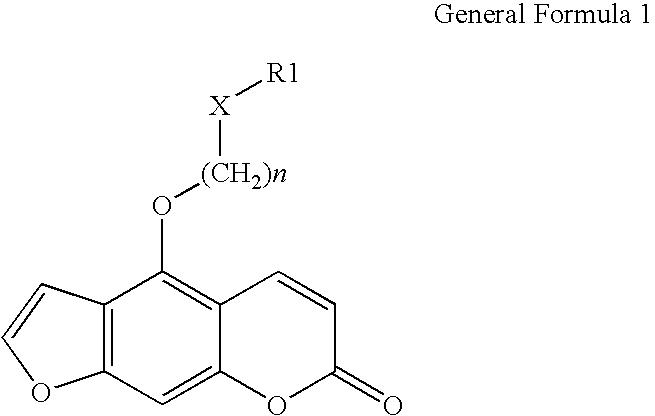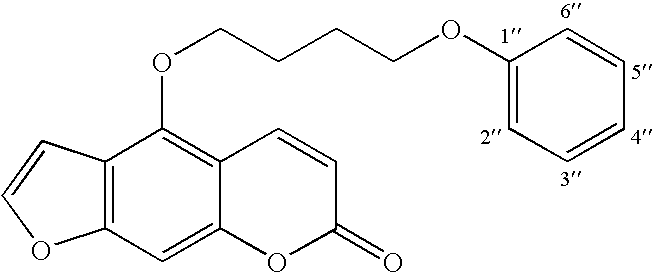5-phenoxyalkoxypsoralens and methods for selective inhibition of the voltage gated Kv1.3 potassium channel
a potassium channel and phenoxyalkoxypsoralen technology, applied in the field of 5phenoxyalkoxypsoralens and methods for selective inhibition of the voltage gated kv1 . 3 potassium channel, can solve the problems of limiting further influx, depolarization of the plasma membrane, and less effective suppression of the secondary dth response, so as to increase the potential for cardiac arrhythmias
- Summary
- Abstract
- Description
- Claims
- Application Information
AI Technical Summary
Benefits of technology
Problems solved by technology
Method used
Image
Examples
example 1
5-(4-Phenoxybutoxy)psoralen (PAP 1)
4-(4-Phenoxybutoxy)-7H-furo[3,2-g][1]benzopyran-7-on
[0030]
[0031]700 mg (3.462 mmol) of 5-hydroxypsoralen (crystallized) and 600 mg (3.462 mmol) of 4-phenoxybutyl bromide was refluxed in 30 ml of 2-butanone in the presence of an excess (2 g) of anhydrous potassium carbonate and catalytic amounts of potassium iodide for 24 hours. The progress of the reaction was monitored by thin layer chromatography. After 24 hours the reaction mixture was concentrated under reduced pressure. The oily residue was cooled and diluted with water. The aqueous solution was then acidified with concentrated hydrochloric acid to pH 1. The slurry was stirred for 15-20 min and extracted with 3×100 ml of dichloromethane. The dichloromethane layer was extracted with 25 ml of 1% sodium hydroxide to separate the un-reacted 5-hydroxypsoralen. The dichloromethane layer was washed with 30 ml of 2% hydrochloric acid, dried over anhydrous sodium sulfate and concentrated. The solid res...
example 2
5-(3-Phenoxypropoxy)psoralen (PAP 3)
4-(3-Phenoxypropoxy)-7H-furo[3,2-g][1]benzopyran-7-on
[0033]
[0034]700 mg (3.5 mmol) of 5-hydroxypsoralen and 750 mg (3.5 mmol) of 3-phenoxypropyl bromide were refluxed in 30 ml of 2-butanone in the presence of an excess of anhydrous potassium carbonate (3.0 g) and catalytic amounts of potassium iodide for 36 hours. The progress of the reaction was monitored by thin layer chromatography. After 36 hours the reaction mixture was concentrated under reduced pressure. The oily residue was cooled and diluted with water. The aqueous solution was then acidified with concentrated hydrochloric acid to pH 1. The slurry was stirred for 15-20 min and extracted with 3×30 ml of dichloromethane. The dichloromethane layer was extracted with 25 ml of 1% sodium hydroxide to separate the un-reacted 5-hydroxypsoralen. The dichloromethane layer was washed with 30 ml of 2% hydrochloric acid, dried over anhydrous sodium sulfate and concentrated. The resulting oily residue ...
example 3
5-(2-Benzyloxyethoxy)psoralen (PAP 5)
4-(2-Benzyloxyethoxy)-7H-furo[3,2-g][1]benzopyran-7-on
[0036]
[0037]600 mg (2.967 mmol) of 5-hydroxypsoralen and 1.0 g (4.649 mmol) of benzyl-2-bromoethyl ether were refluxed in 30 ml of 2-butanone in the presence of an excess of anhydrous potassium carbonate (2.0 g) and catalytic amounts of potassium iodide for 16 hours. The progress of the reaction was monitored by thin layer chromatography. After 16 hours the reaction mixture was concentrated under reduced pressure. The oily residue was cooled and diluted with water. The aqueous solution was then acidified with concentrated hydrochloric acid to pH 1. The slurry was stirred for 15-20 min and extracted with 3×50 ml of dichloromethane. The dichloromethane layer was extracted with 25 ml of 1% sodium hydroxide to separate the un-reacted 5-hydroxypsoralen. The dichloromethane layer was washed with 30 ml of 2% hydrochloric acid, dried over anhydrous sodium sulfate and concentrated. The resulting oily r...
PUM
| Property | Measurement | Unit |
|---|---|---|
| pH | aaaaa | aaaaa |
| composition | aaaaa | aaaaa |
| affinity | aaaaa | aaaaa |
Abstract
Description
Claims
Application Information
 Login to View More
Login to View More - R&D
- Intellectual Property
- Life Sciences
- Materials
- Tech Scout
- Unparalleled Data Quality
- Higher Quality Content
- 60% Fewer Hallucinations
Browse by: Latest US Patents, China's latest patents, Technical Efficacy Thesaurus, Application Domain, Technology Topic, Popular Technical Reports.
© 2025 PatSnap. All rights reserved.Legal|Privacy policy|Modern Slavery Act Transparency Statement|Sitemap|About US| Contact US: help@patsnap.com



